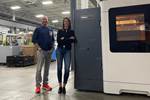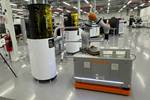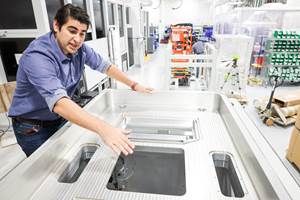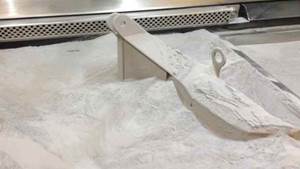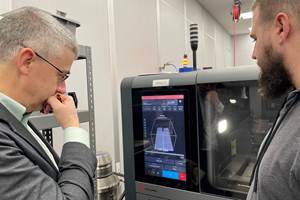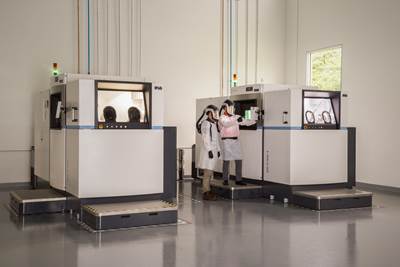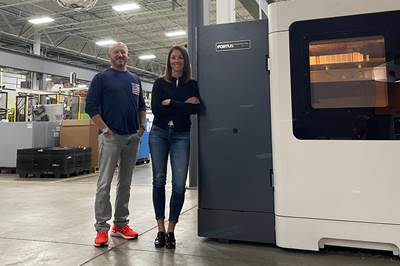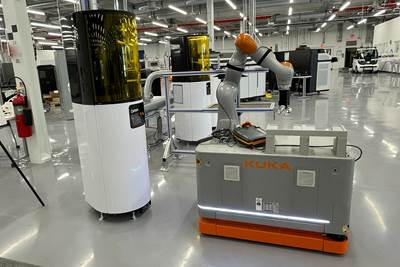Additive manufacturing has made strides into production, even reaching full scale for a growing number of applications. But as AM is applied at greater and more consistent scales, manufacturers using this technology are discovering new and different challenges. Previously small details — like the condensate that collects in filters in a laser powder bed fusion machine — grow to become problems demanding solutions as production scales. We discuss a number of these challenges in this episode of AM Radio, including: dealing with condensate waste, the need for larger material volumes, design considerations for high-volume builds, digitizing workflows that include additive steps, automating AM processes, and the realities of depowdering. (What did we miss? Email us and let us know — we might share it in a future episode!)
Transcript
Stephanie Hendrixson 00:04
Welcome to AM Radio, the show where we tune in to what's going on in additive manufacturing. AM has made huge strides into production, but now that manufacturers are starting to reach full scale, they're starting to find other issues with the technology. Some of these are small and some of them are much larger. We're going to talk about that on AM Radio.
Peter Zelinski 00:28
The AM Radio podcast is brought to you by The Cool Parts Show a video series dedicated to highlighting unique, unusual and innovative 3D printed parts watch episodes at TheCoolPartsShow.com.
Stephanie Hendrixson 00:45
Hello, and welcome to the show. I'm Stephanie Hendrixson. I'm joined in the studio today by Pete Zelinski.
Peter Zelinski
Hey, Stephanie.
Stephanie Hendrixson
So Pete, today, I want to talk about this thing that I've noticed. And it's been on my mind for maybe a little bit more than a year. And sort of the issue is, I've noticed that manufacturers who start to get to scale production through additive manufacturing, begin to see these other challenges and issues that need to be addressed that were not as apparent at a lower scale like not until they reach a certain level of ongoing production, do these things become obvious?
Peter Zelinski 01:21
Yeah, I think I hear where you're going with this. I want to talk about this, what you're what you're sort of describing is the way that as the production quantity gets bigger, seemingly small things scale up as well, and become challenges that have to be faced, you're kind of like, like little things become a big thing. I think there are a lot of examples of that.
Stephanie Hendrixson 01:47
Yeah. So, let me tell you why this came to my mind and sort of the first instance of noticing and realizing this was an issue. So last year, you and I traveled to Florida, we visited a couple of different manufacturers there, one of which was Sintavia. So Sintavia is an aerospace and space parts manufacturer, they use a lot of metal 3D printing, mostly laser powder bed fusion, and they're doing it at a scale that they started to notice that this thing that every laser powder bed fusion user is aware of and has to deal with. And they started to wonder if maybe there was a different solution to this thing that previously wasn't necessarily a problem.
Peter Zelinski
You're talking about condensate.
Stephanie Hendrixson
I'm talking about condensate. So do you want to explain what condensate is?
Peter Zelinski 02:34
Sure. And I remember that we were walking through the facility with Brian Neff, the CEO, and he opened one of the machines to help us understand what condensate is. It's basically soot and powder that blows off of the build while it's in process. It is a small amount of material, it accumulates in a particular place in the machine, in a filter. It is a, it is a difficult byproduct to dispose of. But on the scale of just one machine making parts inconsistently, it is a small item to dispose of. But that's not Sintavia. They’re at scale production with metal additive manufacturing, just as you say. And they are facing the very real challenge of condensate, what do we do with this? And when we were there speaking to them, which is a little while ago now, they were beginning to develop their strategy for how to deal with condensate.
Stephanie Hendrixson 03:35
Yeah, so the typical way that you would deal with the condensate and your filters is you have to inert it. So it has to be mixed with sand or mineral oil, because powdered metal is, is dangerous. And so you have to dispose of it as hazardous waste. But since they got to this level of production, they had so much condensate to deal with, they started to think well wait, there's, there's metal in here. And we print with metal and metal has value. And so is there a way to get the metal back out of the condensate and do something different with this waste that we're producing? So they partnered up with the AMGTA the Additive Manufacturing Green Trade Association, as well as KBM Advanced Materials to kind of study this. And they actually came up with a process that involves mixing the condensate waste with this resin that makes it non-hazardous, makes it possible to ship it to a recycling plant. The recycler can sort of undo this process and get at the metal in the powder. And then, and then recycle it. So this is a great solution that they came up with, where they're taking something that previously was just hazardous waste going into a landfill and finding a way to get it back into the manufacturing cycle. And at a lower scale of production, it might never have occurred to them that this was a problem with potentially a different solution.
Peter Zelinski 04:51
Everything you're describing, I almost knew all of that except the part of this that I'm learning for the first time is they can get the material back out of it, there is actually a reuse loop that closes in this.
Stephanie Hendrixson 05:06
Yeah. So there's been a paper published by the AMGTA about this process, which we can link in the show description.
Peter Zelinski 05:12
Okay, so you started this conversation, and it has to do with additive manufacturing for scale production and the issues that arise the sort of the challenges that poke their head above the surface as they start to grow as quantities scale up, you must have more examples, what's the very next one on your list?
Stephanie Hendrixson 05:32
Oh, so getting away from the condensate and the hazardous waste issue. The next thing I kind of wanted to talk about was just like the material format has to change when you reach a certain level of scale, it becomes impractical to get your, your powder in like small tubs that need to be opened and emptied into different containers. And so I've seen a couple of examples of this in practice. So the one that comes right to mind is GKN Additive at their Auburn Hills facility in Michigan. We were there earlier this year, and they were still sort of, you know, getting equipment in and starting to ramp up production. So we were walking around with Ken Burns, who is the commercial vice president of GKN Additive. And one of the things that he pointed out was like this big cardboard box that was sitting on top of a pallet. And it was one of those things kind of in the background, you wouldn't look at it unless somebody pointed it out to you. But what it was, was they call it an octo-bin. And so it's like this big cardboard box full of powder for their Multi Jet Fusion machines. And from what I understand from our conversation, like that was a whole discussion with HP like, we're gonna go through so much powder, we need it in a bigger container, can you just send us like this larger format of this powder instead of smaller containers that we then have to empty into something else?
Peter Zelinski 06:51
Opening and closing little containers is a drain on time and effort and and inventory management? I'll tell you where I think I first really thought about this. This was a few years ago, but this was another visit. You and I were both there Incodema in New York State. We were walking through that facility with Sean Whittaker, the president and CEO and he walked us by this collection of these shelves where these canisters of powder metal were and they're the, these, these smallish canisters of powder metal that we're familiar with. And he pointed out like, we're going to have to get material in quantities that are, that are bigger than that in packages that are bigger than that. And he was speculating what that might look like. And again, that was, this was a few years ago. But one of the scenarios he envisioned like one day, maybe there's a silo of powder metal.
Stephanie Hendrixson 07:46
So the silo of powder metal scares me a little bit that seems maybe, maybe dangerous, I don't know. But I will say I do think that the materials suppliers and other equipment suppliers are starting to see this need and anticipate it a little bit. So at IMTS in September, one of the booths that I stopped at was Additive Industries. And I talked to Dave Emmett, who is the director of sales and business development for North America. And of course, they had their machine there, but they were also talking about this thing called the powder load tool. And it's sort of like this hopper that is a larger container of metal powder. They developed the solution along with LPW, which is now part of Carpenter Additive. And the idea is that this hopper gets filled with material at the atomizer and then goes straight to the facility. So there's no intermediate stuff with with these buckets and these canisters that need to be opened and filled. So they describe how this is a good solution for customers. It makes their powder handling easier, it lets them get powder in a, in a larger quantity. The atomizers like it too, because it's fewer containers that they have to fill. It's one large thing instead of a lot of little things.
Peter Zelinski 08:52
Right, right. I think I've got an example that fits this theme. Little things that become meaningful as quantities scale up, the one I'm thinking of is the opportunity to make the build more stable or more efficient at delivering high quantities, just through changes you make in build design. A great example of this I saw at IMTS recently, Nexa3D was showing this, this polymer build of 2,600 pulleys all in one photopolymer build on their, in their, their 400 size machine, their larger photopolymer machine, but I had the chance to talk with them about just the thinking and the software optimization, not that goes into part geometry, but that goes into build geometry and nesting and – sidenote, so there was a, there was that set of videos that I did with our friend Tim Simpson a little while back, and it was called AMWTF Why The Failure? and it had to do with as you are in the process of developing a new part for manufacturing through additive, there are opportunities to encounter failure in the build cycle and due to choices you made in part geometry or support structures or what have you, but you get past that point of process development, you get past that point of discovering failure. And then there is this issue you have to face which is optimization, there are opportunities to get the build time down, and to make the build work even better, through some through more subtle choices you make – so, back to Nexa3D and what they showed, okay, 2,600 pulleys. And we will, we will link to this photograph, it is just this towering brick of parts. And so the software is doing things like the support structures look and behave differently at different layers, depending on where they occur vertically, the way the machine works, the parts are suspended from above. So the mass of this collection of parts is increasing steadily as the build progresses and the support structures have to be different to accommodate that. To prevent the, to make sure the build doesn't break off the off the tray off the off the support above it just because the mass is increasing. So that's one thing, but then in addition to that, they engineered it to other subtle considerations, including, and this is so simple, but stagger the heights of different pulleys so that there is not a whole lot of geometry being created, a whole lot of complexity being created in any one layer. Like if it happens to be the slice through a pulley that's particularly geometrically complex. Don't make that happen for all the pulleys in the row at the same time, sort of stagger the height, so that that kind of complexity is happening at different times balance the complexity out. So choices like that, realize a more stable build, and ultimately allow them to achieve a faster build, higher production rate for that scale production through that kind of optimization.
Stephanie Hendrixson 12:24
So I usually think about like nesting parts in in processes that don't require support structures. So something like Multi Jet Fusion or like, arguably, sometimes EBM, you don't necessarily have supports, but you're kind of arguing and what Nexa is sort of discovering is that even a light- and resin-based process where the parts are hanging upside down, and you have these support structures, you still have to think about sort of varying the heights, putting parts in different places in the build, and they've invented a way to do that through software.
Peter Zelinski 12:55
Alright, we got to take a break. I'll be ready. When we come after the break. I've got another example of this in mind, little things that become significant, become issues challenges as additive production scales. I bet you have more examples too. Is that right?
Stephanie Hendrixson
Oh, for sure.
Peter Zelinski
All right, our audience is probably thinking of their own examples. Alright, stay tuned.
I'm Pete Zelinski.
Stephanie Hendrixson 13:19
And I'm Stephanie Hendrixson.
Peter Zelinski 13:21
You've heard us on AM Radio. But we want to tell you about another great place to learn about additive manufacturing. Our video series, The Cool Parts Show.
Stephanie Hendrixson 13:29
In each episode, we highlight a cool 3D printed part that has something to say about where additive manufacturing is headed.
Peter Zelinski 13:35
Join us as we explore the world of custom medical devices, try on the next generation of sustainable footwear, and even follow 3D printed parts to Mars.
Stephanie Hendrixson 13:43
Find all the episodes and subscribe on YouTube or at TheCoolPartsShow.com.
Peter Zelinski 13:51
We're back, AM Radio. I'm Pete Zelinski. And I'm talking to Stephanie Hendrixson and the thing we're talking about is challenges of scale. The little details that become big issues potentially, as additive manufacturing scales up into larger quantity part production. Another example of this comes to mind and it's a little different, Stephanie, than the ones we were talking about before the break. Because this one, I don't know that I see that an answer has been locked in on I just see it as an area of question manufacturers are starting to ask and it has to do with the digital tools for organizing production additive manufacturing, and I'm referring to like a category of software we might call ERP, enterprise resource planning, and it's like organizing the workflow, organizing your capacity, make sure you're using it efficiently. The thing that I have observed is that manufacturers committed to additive for production are in different ways searching for the solution for how to do this, what tools to use? Even what what kinds of information is worth capturing and organizing digitally. And they seem to on a case-by-case basis, they seem to be headed in different individual directions with how to deal with this.
Stephanie Hendrixson 15:27
Oh, yeah, so I've definitely seen this before. So the example that comes right to mind, Tangible Solutions, they are an Ohio manufacturer, they make medical parts, primarily spine implants. And the last time I talked to Chris Collins, who's the chief operating officer, he sort of brought this up and said, like, they've got this ERP system, and it's not perfect, but they just reached a point in production, where they needed some sort of solution, like he described when they were starting out, they were literally doing things like counting the inventory by hand, and like that just wasn't sustainable. So they weren't able to find you know, exactly what they needed on the market. So they're sort of making do with this ERP software that they have. And so it works, it helps to make things like inventory is simpler, but it also has challenges. One of the things he said was like powder is not the same as barstock, you don't just use it, once you're going to feed it back into your production, you need to keep track of it, you need to know how many times it's been reused. And off the shelf options, don't necessarily have ways of doing that for additive right now.
Peter Zelinski 16:32
Yes, considerations in additive that look sort of like other manufacturing process organizational considerations, but actually are distinctly flavored for additive, the way that the material behaves being one of them, some of that material circulates back through and gets reused. And sort of the place where material is at in its reuse life is an important factor that has to be tracked. Another one is how many parts you put on, in a build volume. In laser powder bed fusion, there would be a build plate, and it's got a certain surface area, and you can get a certain number of parts in that surface area, depending on how you arrange them, depending on the, on the geometry of the part. And there might be the opportunity to put unrelated jobs, to nest them together in the same build. Except that is a, that is a challenge to track something like that if they're going to if you're going to do that. Another one is with with with metal additive parts, they leave the facility for processes like HIPing heat treating, and then come back. So you have to track them through that do you do you keep the parts from the same build all together as they go to HIPing and then come back? Probably. You know, and just one more that comes to mind is the strangeness of cycle times in additive manufacturing, the builds are long, and you don't necessarily always want a shorter build time, the thing you really want is build times that coincide very cleanly with, for example, shift changes, so you're loading and unloading parts at exactly the time that you want to. So all of these are things unique to additive, but additive might need to live in a facility with other other manufacturing operations that all have their own considerations like that. And like the software has to coordinate and track it all.
Stephanie Hendrixson 18:31
Right, so we don't just need solutions specific to additive, we need additive solutions that can also support these other technologies or we need maybe the conventional solutions that are out there to have better options for additive so they can all live together somehow.
Peter Zelinski 18:45
Right? Right, live together. And so in the examples I was just giving it was metal metal metal, but but this applies to polymer as well. And so I think of, of RP+M. They are in the, they're sort of, they're sort of in the Cleveland area and they are an additive manufacturer that was spun out of an established injection molder and these two companies are still, have a very close relationship. Now they're all making plastic parts, but RP+M discovered that the ERP system that organized injection molding production just wouldn't work for the ways that 3D printing works. The system that they landed on maybe the one they're still using, they they they found virtues in the system called Shoptech which is actually ERP software for CNC machine shops, but it landed closer to what their FDM 3D printers, which is what they use for production. It landed closer to kind of like the rhythm and flow have that kind of equipment.
Stephanie Hendrixson 19:49
So that's interesting that the plastics additive manufacturing business is actually more like a CNC machining job shop than it is its injection molding parent.
Peter Zelinski
I guess
Stephanie Hendrixson
I bet if we investigate this further, there are probably other people that have done these sort of hacked together systems, there are probably some out there that have developed their own just as a result of this issue.
Peter Zelinski
I'm sure that's true.
Stephanie Hendxison
But hopefully we'll find some sort of solution. The next example of sort of a little big problem that I want to bring up is automation. 3D printing and robots go together in all kinds of ways. But it's also the case that most of these printers are not really set up for automation right out of the box. So the example that I'm thinking of right now is EVCO. They are an injection molder in Wisconsin. And a couple of years ago, this was the cover story of our magazine at one point, they installed a cell of six Markforged 3D printers, they were using these printers for CMM tooling, and also some end use products. One of the opportunities that they found was the ability to serve smaller customers with the 3D printing capacity versus devoting some part of their injection molding business to that work. But they needed to automate this cell. And so they had this Universal Robots cobot that was in front of it that could unload the the completed builds as they finished and put in a new plate and start the next build. But the way that they had to automate it, they basically hacked it together with email, these printers had no support for robot automation, like there was no way to just like tell the printer to talk to the robot. But what they did have was WiFi capability, and the printers would send an automated email when a build completed or when it was stopped for some reason. And so EVCO figured out this whole system where they taught software to basically read the subject line of these emails, and then went through a variety of steps to translate that into instruction for the robot to tell it which printer had stopped, which build needs to be unloaded. And even to the point like the cobot needed to be able to restart the printer, which it wasn't going to be able to do through email. So they put a stylus on the end effector. So like, this is like real life CAPTCHA being circumvented here. But that's what the robot needed to be able to do in order to interact with the touchscreen and start the build. So they made it work. But there were a lot of steps and a lot of sort of pieced together solutions to get there.
Peter Zelinski 22:19
I love that. And so the automation is being driven by emails and by robot fingers pressing buttons. I guess what that makes me think of what it reminds me of is Ford is thinking about in, in in automotive production as additive, in a future in which additive plays a bigger role there, it's clear to them it would be it would be obvious to any production manufacturer, we're going to have to automate these systems. They have a technology center in the Detroit area where they're figuring this out, there's this autonomous robot that roams through that facility named Javier because people need to name their robots. And so fixed automation, a robot that is fixed in place, the way it might serve a different type of machine, that doesn't really make sense for 3D printers. Because the build cycle is so long, an autonomous robot that is free to roam around and go to whatever machine is ready. Like that makes sense. But there are basic obstacles in the way it's just like the the the email stylus type connections that you're describing. These 3D printers at the moment aren't necessarily set up to expect robotic part handling automation. So Ford is working with the the 3D printer manufacturers to sort of make connections between Ford's management software and the software that oversees these machines. That's one thing. But another thing is the Ford the production engineering personnel are are asking questions of these additive equipment makers, like, you know, it would be great if the door opened automatically. But we're to the point now, where considerations like that are what's needed even getting the the platform and access points of the machine at the right level that's convenient for the way robots are designed. All that stuff is where we're at and what we need to figure out.
Stephanie Hendrixson 24:18
Yeah, we're past the point where the assumption is that there's going to be a human operator to open the door and take the parts out. We need to figure out ways of letting robots interact with with these machines.
Peter Zelinski 24:31
Here is, I think, the classic example of little things that become big challenges potentially, I'm talking about depowdering.
Stephanie Hendrixson 24:41
Oh, yeah. Okay, so this is one that I overlooked for a while. One of the other stops that we made on that same trip where we saw Sintavia, we went to Siemens energy, and got to meet SJ Jones, who was there at the time and see all the cool things that they're doing with metal 3D printing, and I specifically remember I heard that they had this machine there, I believe it was from Solukon. And it is a powder removal unit. So one of those systems that has like the turntable inside that will like tilt your part around and maybe vibrate it to shake the powder out. It wasn't running at the time. And I remember I just sort of looked at it and was kind of, okay, that's cool. Let's go talk about the 3D printing, but then last year at Formnext, I stopped by the Solukon booth and learned a lot more about these systems and started to really appreciate the need for them. So if you think about these metal 3D printed parts that can be quite large, quite heavy, that is actually a really difficult task to have somebody tilting and turning this part and trying to get all the powder out. That's not a very repeatable process. If you're trying to do it manually, it's potentially kind of dangerous, and it's probably not the best use of your operator's time. And so a system like this, not only does that let the operator walk away and go do something else, it's repeatable, you can put those parts into the same machine run the same cycle and have some confidence that every part that is the same or similar is going to be clear of powder. So that's one that I overlooked for a while. But I've learned my lesson, I appreciate powder removal systems now.
Peter Zelinski 26:13
Ditto, ditto. So so this, this sophisticated, precise and elegant digital manufacturing process ultimately also needs these mechanical, pivoty, shaky steps to get the powder out. Another example of this that that I saw is Eaton, we've recently covered Eaton’s additive production facility that they've established and they're growing in South Carolina, and one of the capabilities there is is electron beam melting a machine from GE Additive. But right next to that GE Additive Arcam machine is their GE Additive powder recovery station. And it is this system that, that among other things, uses precisely directed high pressure forced air to get powder out of the part and capture it again. And this is a serious consideration. The promise of additive manufacturing is geometrically very intricate parts, complex manifolds and other kinds of parts with channels running all through them and complex components that are the result of assembly consolidation. But none of this works unless you can, you can get clean parts that get all of that loose powder out of the build you've made.
Stephanie Hendrixson 27:34
Yeah, so when we're talking about scale production, we're not just talking about scale 3D printing, we're talking about all of the activities have to scale along with the 3D printing, including these downstream processes.
Peter Zelinski 27:46
We did an episode of The Cool Parts Show recently about the DMG MORI adapter that, it's a component of one of their sophisticated CNC machine tools, it is this sort of this big donut-shaped part that helps to direct coolant for certain types of machining operations. But it's this part that's made through additive manufacturing for a CNC machine tool. And to mass produce this part and do it effectively, they were challenged by getting the powder out. Ultimately, part of their solution was to invent a new vacuum fitting that connected to this part, the vacuum fitting tool was made through additive manufacturing to help with the powder removal for this additive manufactured part.
Stephanie Hendrixson 28:32
Yeah, so again, like DMG MORI, a solution to that problem was to develop something new, something that they hadn't needed before. And I bet we're not done developing new solutions to all of these little additive manufacturing problems.
Peter Zelinski 28:45
Yeah, I bet our audience members are thinking about their own examples of this. As I think back through this conversation, I think what we're really talking about here, it's not additive manufacturing, it's manufacturing. Dealing with these, quote little unquote issues is what manufacturing is all about. All the established, well-established processes deal with this. Issues of workholding or chip handling, or in casting, this new design has a gait that's hard to remove. These little challenges are the big deals in manufacturing, because they're the opportunities for optimization. And what I'm hearing in all this is just a sign of additive getting more mature.
Stephanie Hendrixson 29:26
Yeah, so I think we could go on and on with more examples, but we'll leave it there for today. And listeners, if you have examples of your big little challenge with additive manufacturing that you'd like to share, we'd love to hear about it. So you can reach out to us on social media. We are Additive Manufacturing Media. We're on Twitter, LinkedIn, Facebook, Instagram. You can also email us AMradio@additivemanufacturing.media. Thanks for listening.
AM Radio is recorded with help from Austin Grogan. The show is edited by Jodee McElfresh and me, Stephanie Hendrixson. Our artwork is by Kate Billberry. AM Radio and Additive Manufacturing Media are products of Gardner Business Media located in the Queen City, Cincinnati, Ohio. I'm Stephanie Hendrixson. Thanks for listening.
Related Content
Seurat: Speed Is How AM Competes Against Machining, Casting, Forging
“We don’t ask for DFAM first,” says CEO. A new Boston-area additive manufacturing factory will deliver high-volume metal part production at unit costs beating conventional processes.
Read MoreHow Electroplating Works for Polymer 3D Printed Parts
Baltimore-based RePliForm specializes in electroplating of 3D printed polymer parts for functional applications. This video explores how the process works, and potential benefits and uses for this technique.
Read MorePostprocessing Steps and Costs for Metal 3D Printing
When your metal part is done 3D printing, you just pull it out of the machine and start using it, right? Not exactly.
Read MoreFreeform: Binder Jetting Does Not Change the Basics of Manufacturing
Rather than adapting production methodologies to additive manufacturing, this Pennsylvania contract manufacturer adapts AM to production methodologies. In general, this starts with conversation.
Read MoreRead Next
Scaling Production at Sintavia Reveals Sustainability Challenges with AM
Additive manufacturing has not yet fully confronted all the factors that contribute to sustainability. Sintavia is discovering and working through these issues in metal AM as its production work scales.
Read MoreThe First Choice Was Right: How RP+M Succeeded With Production FDM
This additive manufacturing company narrowed its focus onto the 3D printing capability it knew best and the industry sector best able to benefit from FDM production parts. Characterizing and controlling the process was the breakthrough that has led to production work from Boeing and others.
Read MoreAutonomous Cobot Automation Increases Production 3D Printer Output for Ford (Includes Video)
A mobile robot that travels to each Carbon machine to unload builds lets the automaker run an additional three to four builds per machine per day. Autonomous robots fit well with 3D printing, but their role in production will extend beyond just the additive machines.
Read More

.jpg;width=70;height=70;mode=crop)

